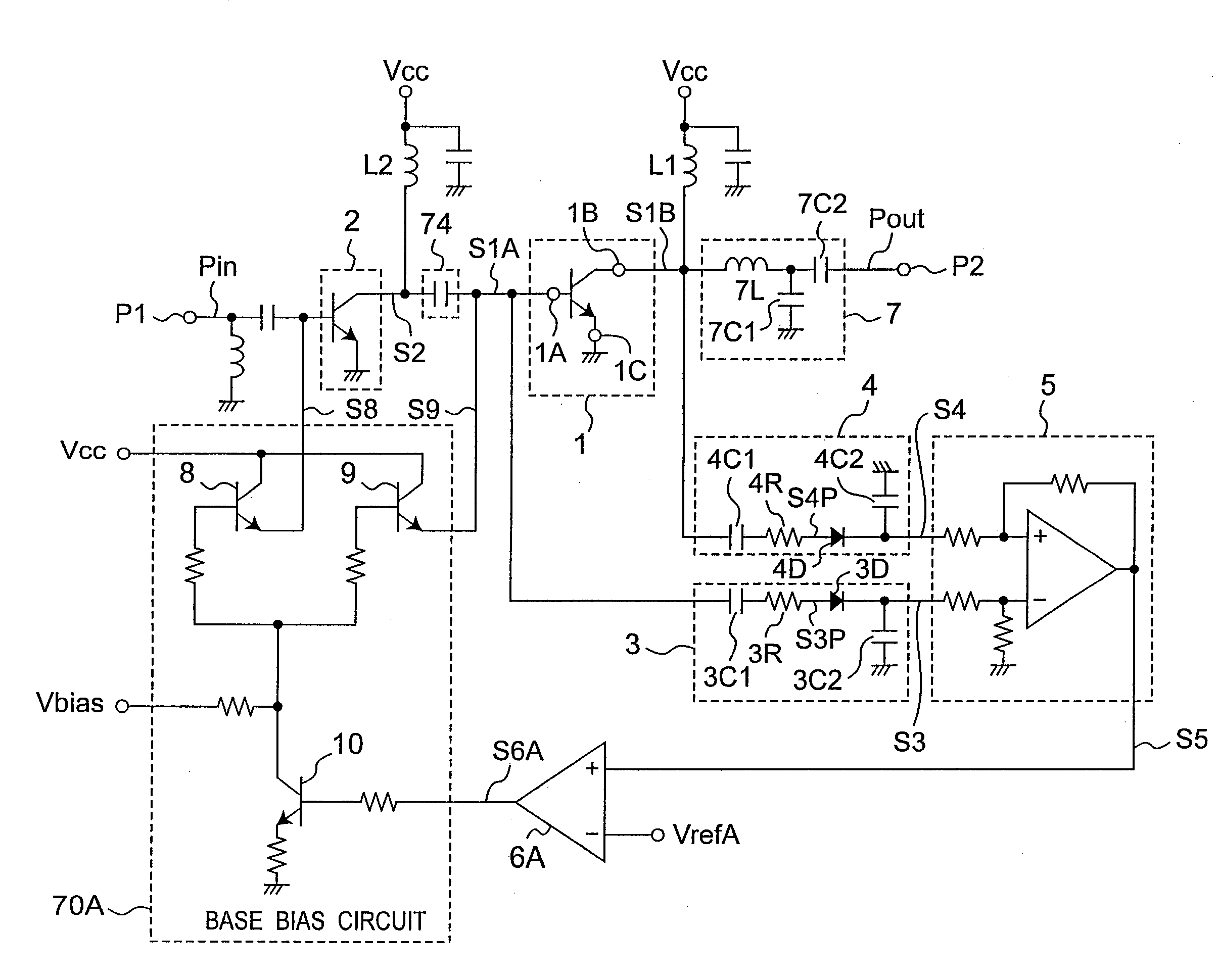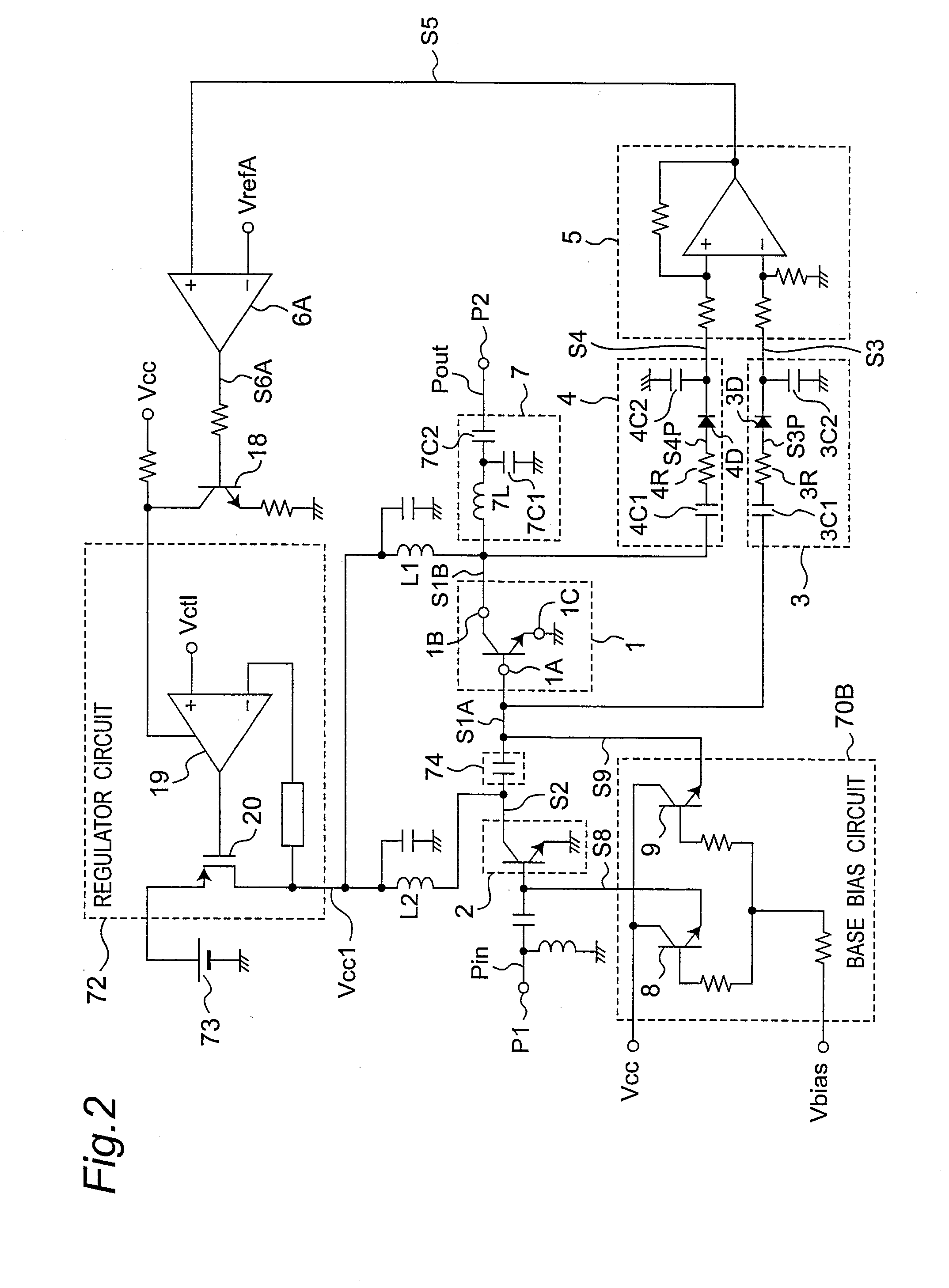Wireless frequency power amplifier, semiconductor device, and wireless frequency power amplification method
- Summary
- Abstract
- Description
- Claims
- Application Information
AI Technical Summary
Benefits of technology
Problems solved by technology
Method used
Image
Examples
embodiment 1
[0059]FIG. 1 is an equivalent circuit diagram showing an example of a wireless frequency power amplifier according to a first embodiment of the invention. As shown in FIG. 1 the wireless frequency power amplifier according to this first embodiment has a transistor 1, a matching circuit 7, and a drive stage 2. An amplifier input signal Terminal is input to the amplifier input node P1. The transistor 1 is also referred to as final stage 1 or amplification stage 1 below. The drive stage 2 is also referred to as amplification stage 2, and the amplifier input signal Terminal is also referred to as a modulation signal.[0060]The modulation signal is generated by modulating a carrier wave with a signal to be modulated based on the modulation method. In the case of a cell phone the signal to be modulated is a voice signal or an Internet data signal, and is an Internet data signal in the case of a wireless local area network (WLAN). In this case, the phase and amplitude of the modulation sign...
embodiment 2
[0085]A wireless frequency power amplifier according to a second embodiment of the invention is described next. Primarily the differences between this embodiment and the first embodiment are described below. Other aspects of the arrangement, operation, and effect of this embodiment are the same as in the first embodiment, and further description thereof is therefore omitted.
[0086]FIG. 2 is an equivalent circuit diagram showing an example of a wireless frequency power amplifier according to a second embodiment of the invention. In the second embodiment as shown in FIG. 2, the base bias circuit 70B outputs predetermined base bias currents S8 and S9 based on a predetermined voltage Vbias without being controlled by the comparator output voltage S6A. In addition, the supply voltage Vcc1 is supplied from a battery 73 through a regulator circuit 72. The supply voltage Vcc1 contains the power supply current, and is therefore also referred to as dc power. The regulator circuit 72 is also re...
embodiment 3
[0092]A wireless frequency power amplifier according to a third embodiment of the invention is described next. Primarily the differences between this embodiment and the first embodiment are described below. Other aspects of the arrangement, operation, and effect of this embodiment are the same as in the first embodiment, and further description thereof is therefore omitted.
[0093]FIG. 3 is an equivalent circuit diagram showing an example of a wireless frequency power amplifier according to a third embodiment of the invention. In the third embodiment as shown in FIG. 3, the base bias circuit 70B outputs predetermined base bias currents S8 and S9 based on a predetermined voltage Vbias without being controlled by the comparator output voltage S6A. In addition, the wireless frequency power amplifier also has a stabilization circuit 28 inserted between the input node 1A and the emitter node 1C (ground node) of the transistor 1. The arrangement including the stabilization circuit 28 and th...
PUM
 Login to View More
Login to View More Abstract
Description
Claims
Application Information
 Login to View More
Login to View More - R&D
- Intellectual Property
- Life Sciences
- Materials
- Tech Scout
- Unparalleled Data Quality
- Higher Quality Content
- 60% Fewer Hallucinations
Browse by: Latest US Patents, China's latest patents, Technical Efficacy Thesaurus, Application Domain, Technology Topic, Popular Technical Reports.
© 2025 PatSnap. All rights reserved.Legal|Privacy policy|Modern Slavery Act Transparency Statement|Sitemap|About US| Contact US: help@patsnap.com



